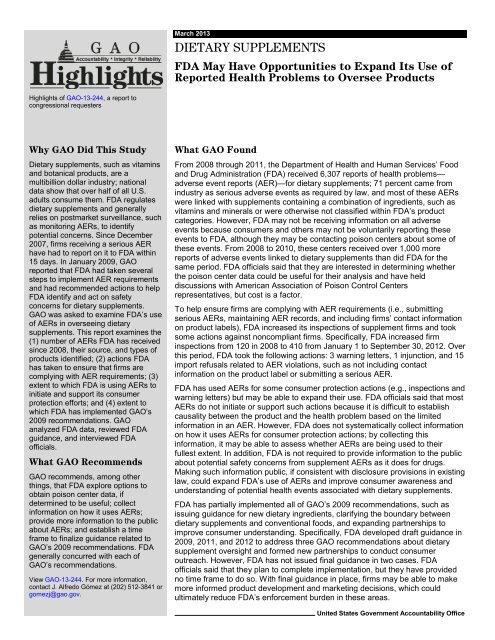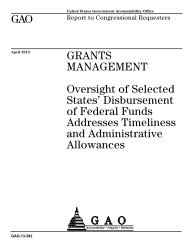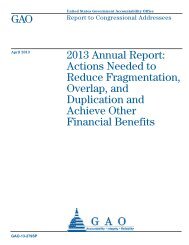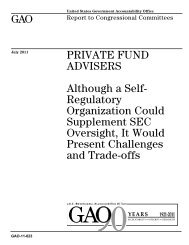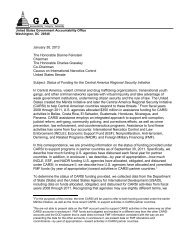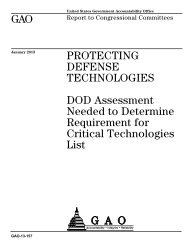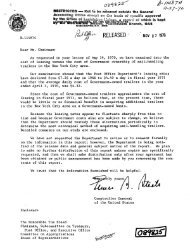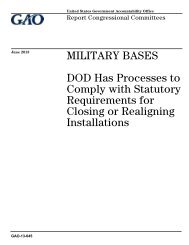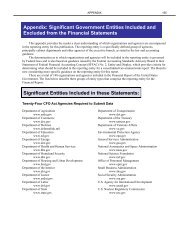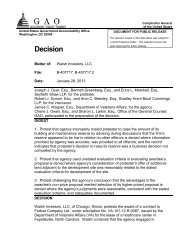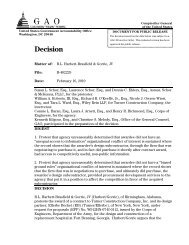Dietary supplements: FDA may have opportunities to expand its use
Dietary supplements: FDA may have opportunities to expand its use
Dietary supplements: FDA may have opportunities to expand its use
Create successful ePaper yourself
Turn your PDF publications into a flip-book with our unique Google optimized e-Paper software.
March 2013<br />
DIETARY SUPPLEMENTS<br />
<strong>FDA</strong> May Have Opportunities <strong>to</strong> Expand Its Use of<br />
Reported Health Problems <strong>to</strong> Oversee Products<br />
Highlights of GAO-13-244, a report <strong>to</strong><br />
congressional requesters<br />
Why GAO Did This Study<br />
<strong>Dietary</strong> <strong>supplements</strong>, such as vitamins<br />
and botanical products, are a<br />
multibillion dollar industry; national<br />
data show that over half of all U.S.<br />
adults consume them. <strong>FDA</strong> regulates<br />
dietary <strong>supplements</strong> and generally<br />
relies on postmarket surveillance, such<br />
as moni<strong>to</strong>ring AERs, <strong>to</strong> identify<br />
potential concerns. Since December<br />
2007, firms receiving a serious AER<br />
<strong>have</strong> had <strong>to</strong> report on it <strong>to</strong> <strong>FDA</strong> within<br />
15 days. In January 2009, GAO<br />
reported that <strong>FDA</strong> had taken several<br />
steps <strong>to</strong> implement AER requirements<br />
and had recommended actions <strong>to</strong> help<br />
<strong>FDA</strong> identify and act on safety<br />
concerns for dietary <strong>supplements</strong>.<br />
GAO was asked <strong>to</strong> examine <strong>FDA</strong>’s <strong>use</strong><br />
of AERs in overseeing dietary<br />
<strong>supplements</strong>. This report examines the<br />
(1) number of AERs <strong>FDA</strong> has received<br />
since 2008, their source, and types of<br />
products identified; (2) actions <strong>FDA</strong><br />
has taken <strong>to</strong> ensure that firms are<br />
complying with AER requirements; (3)<br />
extent <strong>to</strong> which <strong>FDA</strong> is using AERs <strong>to</strong><br />
initiate and support <strong>its</strong> consumer<br />
protection efforts; and (4) extent <strong>to</strong><br />
which <strong>FDA</strong> has implemented GAO’s<br />
2009 recommendations. GAO<br />
analyzed <strong>FDA</strong> data, reviewed <strong>FDA</strong><br />
guidance, and interviewed <strong>FDA</strong><br />
officials.<br />
What GAO Recommends<br />
GAO recommends, among other<br />
things, that <strong>FDA</strong> explore options <strong>to</strong><br />
obtain poison center data, if<br />
determined <strong>to</strong> be <strong>use</strong>ful; collect<br />
information on how it <strong>use</strong>s AERs;<br />
provide more information <strong>to</strong> the public<br />
about AERs; and establish a time<br />
frame <strong>to</strong> finalize guidance related <strong>to</strong><br />
GAO’s 2009 recommendations. <strong>FDA</strong><br />
generally concurred with each of<br />
GAO’s recommendations.<br />
View GAO-13-244. For more information,<br />
contact J. Alfredo Gómez at (202) 512-3841 or<br />
gomezj@gao.gov.<br />
What GAO Found<br />
From 2008 through 2011, the Department of Health and Human Services’ Food<br />
and Drug Administration (<strong>FDA</strong>) received 6,307 reports of health problems—<br />
adverse event reports (AER)—for dietary <strong>supplements</strong>; 71 percent came from<br />
industry as serious adverse events as required by law, and most of these AERs<br />
were linked with <strong>supplements</strong> containing a combination of ingredients, such as<br />
vitamins and minerals or were otherwise not classified within <strong>FDA</strong>’s product<br />
categories. However, <strong>FDA</strong> <strong>may</strong> not be receiving information on all adverse<br />
events beca<strong>use</strong> consumers and others <strong>may</strong> not be voluntarily reporting these<br />
events <strong>to</strong> <strong>FDA</strong>, although they <strong>may</strong> be contacting poison centers about some of<br />
these events. From 2008 <strong>to</strong> 2010, these centers received over 1,000 more<br />
reports of adverse events linked <strong>to</strong> dietary <strong>supplements</strong> than did <strong>FDA</strong> for the<br />
same period. <strong>FDA</strong> officials said that they are interested in determining whether<br />
the poison center data could be <strong>use</strong>ful for their analysis and <strong>have</strong> held<br />
discussions with American Association of Poison Control Centers<br />
representatives, but cost is a fac<strong>to</strong>r.<br />
To help ensure firms are complying with AER requirements (i.e., submitting<br />
serious AERs, maintaining AER records, and including firms’ contact information<br />
on product labels), <strong>FDA</strong> increased <strong>its</strong> inspections of supplement firms and <strong>to</strong>ok<br />
some actions against noncompliant firms. Specifically, <strong>FDA</strong> increased firm<br />
inspections from 120 in 2008 <strong>to</strong> 410 from January 1 <strong>to</strong> September 30, 2012. Over<br />
this period, <strong>FDA</strong> <strong>to</strong>ok the following actions: 3 warning letters, 1 injunction, and 15<br />
import refusals related <strong>to</strong> AER violations, such as not including contact<br />
information on the product label or submitting a serious AER.<br />
<strong>FDA</strong> has <strong>use</strong>d AERs for some consumer protection actions (e.g., inspections and<br />
warning letters) but <strong>may</strong> be able <strong>to</strong> <strong>expand</strong> their <strong>use</strong>. <strong>FDA</strong> officials said that most<br />
AERs do not initiate or support such actions beca<strong>use</strong> it is difficult <strong>to</strong> establish<br />
causality between the product and the health problem based on the limited<br />
information in an AER. However, <strong>FDA</strong> does not systematically collect information<br />
on how it <strong>use</strong>s AERs for consumer protection actions; by collecting this<br />
information, it <strong>may</strong> be able <strong>to</strong> assess whether AERs are being <strong>use</strong>d <strong>to</strong> their<br />
fullest extent. In addition, <strong>FDA</strong> is not required <strong>to</strong> provide information <strong>to</strong> the public<br />
about potential safety concerns from supplement AERs as it does for drugs.<br />
Making such information public, if consistent with disclosure provisions in existing<br />
law, could <strong>expand</strong> <strong>FDA</strong>’s <strong>use</strong> of AERs and improve consumer awareness and<br />
understanding of potential health events associated with dietary <strong>supplements</strong>.<br />
<strong>FDA</strong> has partially implemented all of GAO’s 2009 recommendations, such as<br />
issuing guidance for new dietary ingredients, clarifying the boundary between<br />
dietary <strong>supplements</strong> and conventional foods, and <strong>expand</strong>ing partnerships <strong>to</strong><br />
improve consumer understanding. Specifically, <strong>FDA</strong> developed draft guidance in<br />
2009, 2011, and 2012 <strong>to</strong> address three GAO recommendations about dietary<br />
supplement oversight and formed new partnerships <strong>to</strong> conduct consumer<br />
outreach. However, <strong>FDA</strong> has not issued final guidance in two cases. <strong>FDA</strong><br />
officials said that they plan <strong>to</strong> complete implementation, but they <strong>have</strong> provided<br />
no time frame <strong>to</strong> do so. With final guidance in place, firms <strong>may</strong> be able <strong>to</strong> make<br />
more informed product development and marketing decisions, which could<br />
ultimately reduce <strong>FDA</strong>’s enforcement burden in these areas.<br />
United States Government Accountability Office


